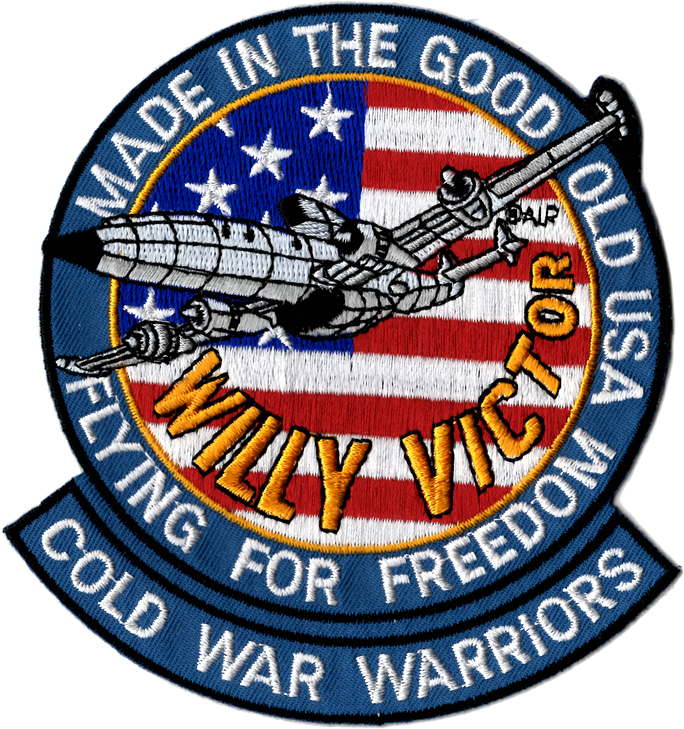September, 1958
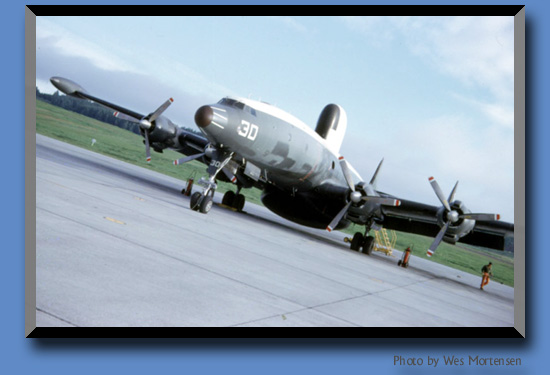
SKY SENTINEL—These 71-ton planes maintain a constant vigil along the vast ocean expanse between Adak and Midway. Each “Connie” produces enough electrical power to supply a city of 20,000, carries six tons of electronic equipment.
The Pacific Barrier is a means to an end.
From Alaska to Midway Island it is 1,500 miles. Much of the year this distance is shrouded in fog—the same kind of fog that hid Japanese fleets approaching Pearl Harbor and Midway 17 years ago. In the upper altitudes flows a west-to-east jet stream from Kamchatka on the Siberian peninsula to the Pacific Coast of North America.
Until early 1958 this was considered a likely course for air invaders seeking to outflank detection and the defense line across Canada blocking the Polar route. The Pacific coast stood as nearly naked as it did in 1946, for excepting the radar aboard an occasional patrolling ship, our early warning system halted in Alaska. A grave situation, this unguarded 1,500-mile-wide door through which global-spanning nuclear-laden supersonic bombers could pass must be closed.
The initial action to do just that, to extend the DEW (Distant Early Warning) Line an additional 1,500 miles into the Pacific came in January, 1956, with the establishment of Airborne Early Warning Wing Pacific, This Wing of radar-packed Super Constellations, together with the surface radar pickets of Destroyer Escort Squadron SEVEN, (also yet to be formed) would make up Barrier Pacific, and thus extend North America’s early warning system on to the mid-Pacific. Then this was but a plan, and for the officers and men who became directly involved in making it a reality, it was a tremendous challenge.
The challenge was met and the seeds of reality reaped. Now there is an organization of aircraft, ships and equipment valued at some $350,000,000. Headed by Rear Admiral BENJAMIN B. MOORE, USN, the Barrier became fully operational on 1 July, 1958, and on that day an intricate chain of radar defenses went “on watch” 24 hours a day, 7 days a week. A ship or aircraft moving across this 1,500—mile expanse will alight radar scopes likened to Broadway on Christmas Eve.
Like all things worthwhile,however, the two commands which make up Barrier Pacific were not easily come by.
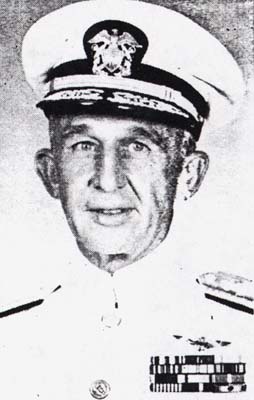
BARRIER COMMANDER —Rear Admiral Benjamin E.Moore, Commander Barrier Pacific and Commander Airborne Early Warning Wing Pacific. Before coming to the Pacific, Admiral Moore was Commander Carrier Division 14 in the Atlantic: more re-cently, he was Commander Fleet Air Hawai.
THE PACIFIC WING
After the Wing Staff was commissioned, the Chief of Naval Operations had set forth orders for a four squadron Wing in the Pacific. Target date: 1 July 1958. Not only would a large airline have to be built and made operational in two and a half years, a vast communications network would also have to be engineered and built to make the envisioned radar barrier effective.
A comprehensive study of commercial airlines operating and maintenance procedures was made. This Wing and the commercial carriers had two things in common: the same type aircraft — Lockheed Super Constellations, and extended flights. There loomed a difference, however. The Barrier flights would be 16 hours in duration, non-stop, and often in the most severe type of weather.
Having to fly under these conditions, the flight crews could not shoulder the major line maintenance responsibilities as in conventional Navy squadrons. Therefore, it was deduced, to operate this unique airline effectively and economically, three things were necessary: (a) standard scheduled flight operations, (b) fixed-base logistic support, and (c) flight and logistic support personnel in separate commands.
In April, this plan was presented to the Navy Department. In May, a directive arrived: “Implement the Air Maintenance and Training and Operating Squadron concept.” It was a red letter day for the planners.
The following July, Air Barrier Service Squadron-2 and one operating squadron, VW - 12, were commissioned, followed by two additional operating squadrons, VW’s 14 and 16. (Due to budgetary limitations, however, October 1, 1957, VW-16 was de-commissioned.)
What about overhaul?
The Navy way of maintaining its transport type aircraft was, after 1,400 flight hours, to return them to an overhaul and repair facility for major maintenance and overhaul. This pro-cedure on a radar-packed Super Con~tellation could tie it up an estimated period of four months. On the other hand, commercial air lines used a progressive maintenance system which greatly reduced time "off the line.”
Adopting this procedure, progressive maintenance was contracted with Lockheed Aircraft Services, Inc., and they set up shop in Navy facilities at Honolulu International Airport. Now, rather than flying the airplanes back to the U, S. and taking them out of service for this prolonged period, the Pacific Wing simply flies them 15 minutes to Honolulu International a n d turns them over to the Lockheed specialists. The planes are back on the Barrier in 10 to 15 days, reducing depreciation which amounts to about $565 a day. The commercial concept had come to the Navy — and it is working.

EXPERIENCED MECHANICS keep the AEW planes on schedule along the 1,500-mile Pacific barrier.
RADAR PICKETS
With their WW II jobs completed, the Destroyer Escort Radar picket ships (DER’s) now manning the Pacific Barrier were placed in mothballs. They remained there until 1950 when the challenge of air defense required these proud little ships to serve again.
They went to shipyards where they underwent extensive modification and emerged floating radar sets. In the main, this consisted of enlarging the ships’ nerve centers — Combat Information Centers—to handle data fed by the new air search, height-finder and surface search radar. Too, the center portion of the main deck had to be enclosed and a superstructure added to provide more and spacious living quarters for the 160-man crew,
These modifications added more than 400 tons to the escorts’ displacement. Small but heavy, they are rough-riders and far from comfortable. Often the risks are great as these ships always remain on station regardless of weather conditions. Work aboard the DERs is harder than in most ships, yet an attraction for duty aboard them defies analysis. Most men who serve aboard them in the Pacific will, without the slightest hesitation, tell you that they are the most important ships in the Navy. They believe this because theirs are the only type ships in the fleet that are actually performing their regular mission on an around-the-clock basis. Like the Barrier aircraft, they are engaged in their ultimate functions, not engaged in peacetime training.
In 1956, two DERs were as-signed to the Pacific Barrier and home-ported at Pearl Harbor. On 18 August 1957, Escort Squadron SEVEN was formed and commissioned on the East Coast. Since, fourteen DERs have joined the squadron.
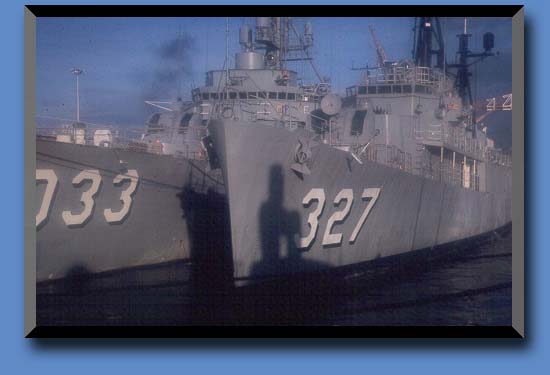
PACIFIC BARRIER’s surface units, DERs, take a breather at their home port Pearl Harbor, between periods of rugged patrol duty in the North Pacific. Besides carryinig out their primary duties as radar pickets, they also serve as navigational aids and as search- and -rescue vessels.
Question: With all these ships, aircraft and men, plus an outlay of some $350,000,000, is the Barrier effective?
Let’s go to the jump-off point, Midway Island, and go on a typical radar patrol flight.
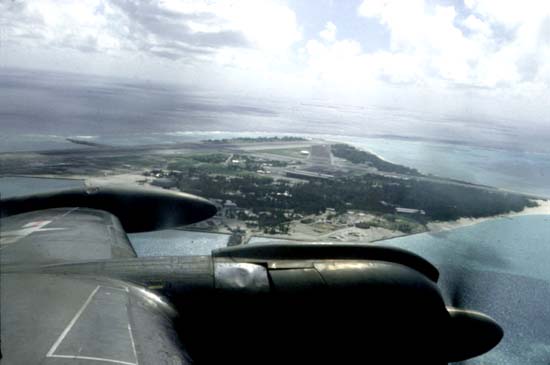
Midway Island___ Our home away from home for an eighteen day deployment, during which seven barrier missions will be flown. At approximately 14 1/2 hours per mission (not including pre-flight briefing and preperations and post-flight duties), we will fly approximately 102 hours per deployment.
A SEARCH FOR NOTHING
It is 2 am., and it is raining.
If it were not for the lighted windows one could not see the hump-backed, pot-bellied, 71-ton aircraft.
Inside, 20 young Navy men sit and wait. They have nothing to do—yet. Three more in the flight compartment are twisting dials, flicking switches and barking in a monotonous staccato. Engines strain and propellers bite into the wet night. After a few moments we are airborne, heading north over the Pacific.
Where are we going?
Nowhere. But it will take 16 fatiguing hours to get back.
The crew unbuckles, stretches a bit and commences to break out charts, computers and plotting devices. The officer in charge of the Combat Information Center (CIC) requests the aircraft commander’s permission to turn on the "Connie’s” six tons of radar equipment. This system has some 3,000 electronic tubes and develops enough power to supply a city of
20,000.

THE HAWAIIAN Islands, as seen by radar from 10,000 feet. Islands, diagonally from top to bottom: Oahu, Molokai. Lanai, Maui and Hawaii.
The aircraft commander issues his permission, pushes his forehead against the rain-spattered window and makes a wry face. The co-pilot goes over his cheek-off list and calls over his shoulder to the flight engineer for a change in power setting. The flight engineer repeats the order and adjusts the power output of the four engines.
The navigator scrawls some letters and numbers on a note pad, pushes away from his table and starts forward. On passing through the stainless steel galley, he draws a cup Of coffee, moves to the flight compartment and hands note and coffee to the aircraft commander. He scans the information and adjusts the auto pilot. The plane banks slowly and finds its new course in the darkness.
Three o’clock am. The rain increases Throughout the huge plane there is intense but controlled activity. In the dim CIC Room five radar operators hunch over their consoles, gazing at the green and amber Scopes.
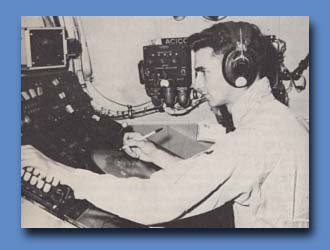
THE WATCHERS WATCHED—A CIC officer carefully supervises his radar scope watches aboard the big Super-Connie.
The CIC officer paces back and forth through the room watching the deft movements of his scope watchers. A “bogie” (unidentified Aircraft) flicks brightly on the scopes. Immediately it is tagged at 155 miles distant, heading East at 270 miles an hour, and flying at 17,000 feet altitude. The radioman raps his key. The message is to the Operational Control Center on Oahu, Hawaii. There nine officers and 32 enlisted men have plotted on lighted, wall-size charts the positions and courses of all known friendly air and sea traffic.
The galley refrigerator door slams. The electrician and duty chef toss 24 frozen T-bone steaks on the sink to thaw, break out the large electric frying pan and send an off-duty crewman through the plane taking orders — rare, medium well, done, etc.; also, the eggs— up, over ... Breakfast in a couple of hours. In the mean-time there are fruits, coffee, milk and juices.
In this command as well as in marriage, the belief is strong that the way to a man’s contentment is through his stomach. Every effort is made to better in the air what the men normally eat in the base mess hall,
The airplane drones on. Crazy patterns appear on the scopes. A heavy cumulus formation is gathering 50 miles ahead. The ride gets bumpier.
A message comes in from the Operational Control Center. The ‘‘bogie" spotted eight minutes ago has been identified as a Northwest-Orient airliner heading for the Seattle-Tacoma airport. If the men at the Control Center could not have identified the "bogie,” Continental Air Defense in Colorado Springs, Colorado, would have been notifled and it would have “scrambled” the jet interceptors in Hawaii and Alaska and alerted the West Coast.
It’s 4 am. The radar watch changes. Three operators come into the galley blinking like moles. They flop down at the table. One explains:
“It’s really tough. When you get away from the scopes your eyes weigh a ton.”
“You get scope blindness if you don’t do it right,” answers another.
‘Yeah, thats right.” volunteers a third. “It’s best to scan around the scope, or else you’ll get all hung up.”
One of these young radarmen will soon hit the bunk for three hours, go back on scope for one hour, then switch to the plotting table, then another three-hour nap.
The aircraft commander comes into the galley and slides in at the table beside his men. A jawing session ensues—pre- emptive concept, dialectic materialism, Marilyn Monroe—you, know...
We cross Latitude 40 North and all hands get into their rubberized immersion suits. If it becomes necessary to ditch during the next few hours, these suits might save lives. Thirty minutes in the waters below without them and you’re a very cold corpse.
A ‘skunk” (unidentified ship) flares on the scopes. The same procedure as with the ‘bogie is repeated. It is soon identifled as a Vancouver-bound cargo vessel.
Its daylight now. Above is the west-to-east, 100-mile-an-hour jet stream; below, soupy clouds and icy water.
The CIC officer gets a radar picket on the wire. These ships, besides serving as radar patrols, double up as search and rescue and navigational aids. They "swap positions,” the ship gives a weather report.
The CIC officer explains: “Ours is always a welcome talk You see, they stay down there for 20—30 days, and if it weren't for us they’d soon forget that there was anyone left in the world. And we’re mighty glad to know they’re there, believe me — especially when we start thinking of taking a swim.”

THE PACIFIC BARRIER—It is designed to prevent an “end run" around radar outposts in the arctic by craft bent on attacking the U.S. from the Pacific.
In the galley the aircraft commander opened up about the Pacific Wing.
“Training was our biggest job here,” he explains. “Every one of these men goes through months of specialized schooling, then months more in the Wing’s ground school and in the air."
“Example: Take our young pilots. After 500 Pilot hours in multi-engine training they go into a specialized training course peculiar to WV-2 type aircraft. It takes 16 months of constant flying to qualify for 2nd pilot, and 24 months to gain the experience and knowledge required for aircraft commander. This is a sizeable order for any junior officer."
“The planes are equipped with an estimated $2,000,000 of electronic and other technical equipment which must be continually manned and efficiently operated throughout the entire flight. The aircraft commander is responsible for the constant supervision and coordination of ais crew, and he must be thoroughly familiar with the functions and limitations of the vast amount of complex equipment. He must not only be among the most experienced in aviation available, he must be a highly competent Combat Information Officer as well."
“The WV-2 type aircraft commander is experienced in the operational and tactical employment of surface elements and is qualified to set up radar barriers to cover movements of fleets. Also, he must have the qualities of leadership required for the command of crews and to conduct advanced base or detachment unit operations as officer-in-charge."
"And the flight engineers. All senior petty officers and experienced mechanics, they attend 12 weeks of intensive ground school training followed by an-other 2 1/2 to 3 months of flight training before reporting to their squadron as a 2nd engineer. Before they can qualify as a 1st engineer these men have to put in over 110 hours of flight panel operation aboard a radar 'Connie' in flight.”
"We’ve trained 55 complete crews out here since commissioning. And there’ll have to be many more. The attrition due to discharges is considerable. Some eighty percent of our crews are young men on their obligated tours. They are the best in the business and I’d like to add, if ours are a cross section of the young men filling our Navy ranks today. we are in mighty good shape and as proud as punch.”
There was no need to ask about morale. A few minutes with these cheerful but serious people was sufficient to see that morale was exceptionally high. This could cause one to wonder as to the “whys,” for the very nature of such a mission would normally dictate the opposite: Everyone is on a war footing, but there is no war; the aircraft aren’t sleek. supersonic fighters, so no speed records avail themselves, and there are no powerful guns with which to earn E’s.
The flights are a compound of monotony, fatigue and boredom, and everyone is weary and eye-sore from looking at something they hope fervently they never find. There is inadequate housing for dependents and crowded or far-away schools for the children, and the cost of living is out of proportion with pay. On the surface, seemingly there isn’t quite enough of anything but work. Analyzing deeper, though, you find the traits of good leadership on every level of responsibility, The crews are tight-knit with a strong sense of comradeship. The senior officers are genuinely concerned over the welfare of their personnel, and on the job they permit all subordinates a full measure of freedom to “produce.”
The daylight hours pass. It becomes night again. Pilots, navigators, radiomen and scope watchers concentrate on their tasks. Men off-duty loll in foam-rubber chairs, g o i n g over manuals, schematics; some sleep in foam-rubber bunks aft. Seven o’clock. Eight o’clock. Soon the runway ljghts pierce the overcrast. The flight engineer pressurizes the aircraft interior to three pounds per square inch. If a large “gooney bird” crashes into the windshield, the pressure will tend to push him outward instead of the bird slashing through the cabin and injurying personnel.
GCA (Ground Control Approach) puts us on the coral atoll. The crew debarks wearily and disappears into another rainy night. In a few hours they will do it all over again.
Sixteen hours, a four million dollar airplane. 23 tons of fuel, pinpoint navigation, 23 highly trained men, thousands of miles: one search of thousands to come.
For what?
For one little unfriendly “blip” on a radar scope. But one hundred and sixty million Americans should join these crewmen in hoping that that “blip” never appears, and that all the thousands of searches to come will be just like this one —all for nothing.
“But in case the 'blip' should appear,” related Admiral Moore solemnly, “the nation’s early warning instrument is intact. Should an enemy madly decide on an all—out attack on the northern hemisphere, the Pacific Barrier and its Atlantic counterpart plus the Canadian DEW and Pine Tree Lines avould alert the Strategic Air fommand, the Continental Air Defense organizations and the Civil Defense authorities. The safety of our nation depends on this early warning.”
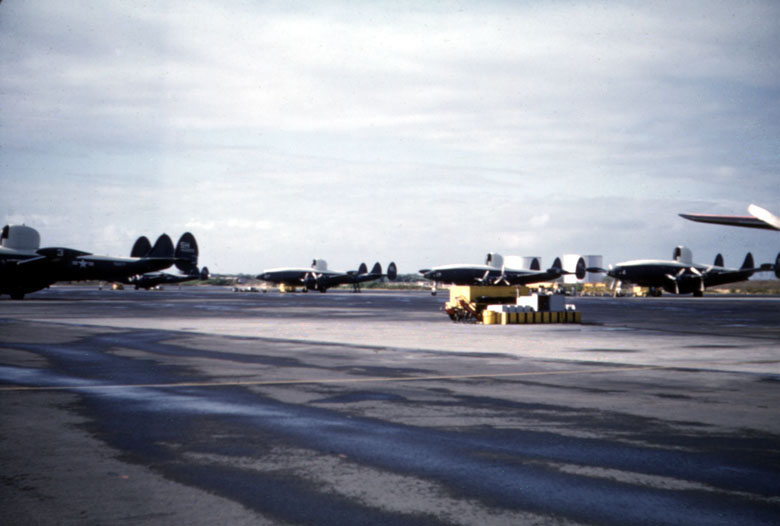
HOME TO ROOST—Home base for the numerous radar-packed Super Constellations (WV-2s) of Airborne Early warningWing Pacific is NAS Barber’s Point.
CONSEQUENCES PROFOUND
Adding this large and unique organization to our national defense establishment has etched a sizeable mark in many places.
The Navy as a whole has profited considerably, primarily in three areas: Soon after the Pacific Wing planners "sold” their ideas, Airborne Early Warning Wing Atlantic adopted the commercial air line maintenance and operational concept; also, transport and patrol squadrons are adopting the same system. The airline work card system for maintenance developed by the Pacific Wing is accepted as Bureau of Aeronautics Standard, and Aerology requirements have improved weather control organization and service to the fleets.
In the Hawaiian area the presence of the Pacific Barrier has exerted a tremendous inpact. Tiny Midway, the once forgotten isolated atoll, has had life pumped into its veins to the tune of some 40 million dollars. Now, instead of a sleeping embryo, it is a bastion of defense. Not only has it been completely rebuilt, the personnel complement there has more than doubled.
On Oahu, big things have happened also. Since the Early Warning squadrons set up housekeeping and brought in their sprawling shops to NAS Barber’s Point station facilities and personnel have nearly doubled. From one officer and two enlisted men, the Wing has grown to some 2400 officers and men. And with their coming to Hawaii, came some 6000 dependents. It is a similar story at Pearl Harbor with the presence of Escort Squadron SEVEN’s 2,000 personnel and approximately 4,000 dependents.
The Lockheed Aircraft Service facilities at Honolulu International has a work force of more than 400 permanent employees and an annual pay-roll of approximately $2,000,000. Add this to an annual Navy pay-roll of approximately $15,000,000, and you see that in pay alone, Admiral Moore’s command is pumping nearly eighteen million dollars yearly into the Hawaiian economy.
PROBLEMS TO OVERCOME
In contrast to all this expanding, the schools, housing and most all other community necessities have been unable to keep pace. There is but one elementary school in the Barber’s Point area. Children in higher grades (and there are many) ride school buses the 20 miles to Pearl Harbor.
There are a total of 949 dependents’ quarters available —half quonset, half Capehart. The waiting period for occupancy is approximately 12 months, and currently the waiting list contains some 850 names. There is some measure of housing relief expected, however, as contract bids were recently let for 1140 new Capehart units. These a. expected to start becoming available for occupancy in l959.
In time, however, these problems, like the many other which confronted the Barrier organizers, will be solved, for from the day of this command’s inception there has prevailed an atmosphere of optimism, zeal, confidence and organization know-how. From the commander on down, there is a common belief that America’s lifeline is its early warning system, and until something revolutionary indeed merits replacing it. the Pacific Barrier will have the job of manning the 1,500-mile gate that protects the Pacific shores of the United States . . . and in accomplishing this end the means by which it is done is of minute significance.
Douglas Burnett Mauldin.
AMC, US.
